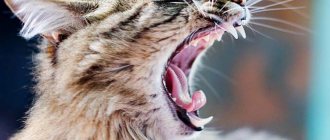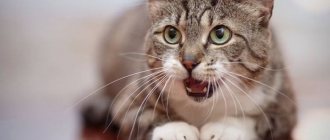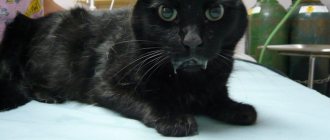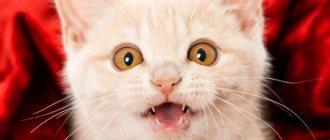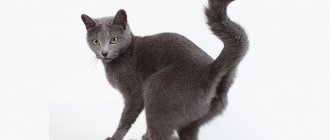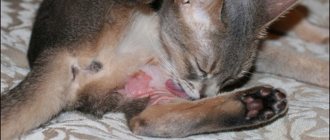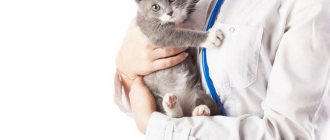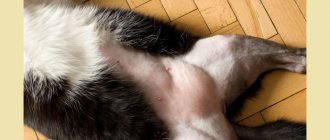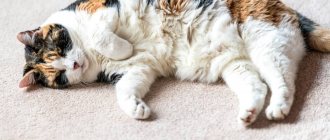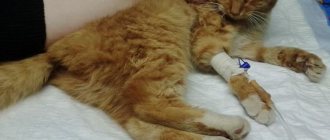Why does a cat's belly go bald: reasons
The process of changing fur in cats is called molting. There are physiological and pathological molting. Nature has decreed that cats have thicker fur on their backs than on their bellies. Therefore, with severe hair loss, the stomach is exposed first.
Physiological hair loss in cats
The cat has adapted to living in an apartment or house. Seasonal molting, characteristic of wild animals, does not occur in cats. Old hairs are gradually replaced by new ones.
However, at certain moments the intensity of hair loss increases for the following reasons:
- Juvenile shedding: begins in kittens older than 5 months and lasts up to three months. The baby's fur is replaced with a new one.
- Pregnancy and lactation: under the influence of hormones, the hair on the belly falls out. In newborn kittens, thermoregulation is imperfect, so it is necessary for the mother to warm them with her bare belly. In order for the cubs to quickly make their way to the nipples, there should be no hair around.
- Old age: in older animals, the hormonal status changes, chronic liver diseases occur, which lead to thinning of the coat.
- Congenital anomalies are caused by the physiology of the cat. Hypotrichosis begins to develop in kittens older than four months. The fur on the belly comes out first. Gradually, the pet's entire body becomes bald. He looks healthy, but is constantly cold and needs clothes.
Be sure to read:
Why does a cat bite and gnaw its tail strongly, sometimes until it bleeds? Should I be worried?
When to be wary: 8 pathological reasons
The following factors cause hair loss on the abdomen:
- Imbalanced diet . Eating economy-class food or natural products leads to a lack of building material for hair formation. Pathological molting is caused not only by a deficiency of vitamins, but also by an overdose due to the uncontrolled use of feed additives or fortified treats.
- Lice eaters are ectoparasites that feed on wool.
- Helminths: secrete endotoxins that damage hair follicles and also interfere with the absorption of vitamins from the gastrointestinal tract.
- Stress - moving, traveling, visiting exhibitions, the appearance of a new pet in the apartment, fear, can cause an inadequate reaction and shedding of fur.
- Allergy : to food components, household chemicals, cosmetics, hair of other animals, insecticides. The skin itches, the cat intensively licks problem areas, including the stomach and hind legs, which leads to ripping out hairs from the hair follicles.
- Physical and chemical factors. If the apartment is hot, the air is dry, thermoregulation is disrupted and the animal tries to escape from overheating by shedding excess “clothes.” Frequent bathing contributes to hair loss: detergents destroy the protective shell of the hairs. They become brittle and crumble.
- Hormonal imbalances that occur due to diseases of the thyroid gland, adrenal glands, and uncontrolled use of steroid drugs.
- Chronic intoxication occurs when consuming feed contaminated with fungi or containing toxic substances. In order to get rid of poisons, the body uses all mechanisms: diarrhea, vomiting, shedding hair.
The main manifestations of various causes of baldness
You can understand what causes a receding hairline by paying attention to a number of symptoms. They often allow you to find out, even without examination, the reason why hair is growing on your cat’s belly.
If your cat's belly is going bald, it is imperative that you consult a veterinarian to determine the cause and carry out proper treatment.
What to do if your cat’s stomach and hind legs are going bald: treatment
Treatment consists of eliminating the causes of the disease:
- Conduct a diet analysis and switch to premium or higher hypoallergenic ready-made food. With this approach, no additional vitamin supplements are required.
- Bring content parameters in accordance with standards. Move the cat's bed away from the heating radiator and use a humidifier.
- Use antiparasitic insecticides to kill lice eaters, fleas, and at the same time helminths. Drops of Spot-on, IN-AP or analogues are in demand.
- Discontinue medications that may cause allergic reactions. Report this to your veterinarian.
- Use anti-stress medications: Stop-Stress, Stop-itching, Vetspokoin.
Be sure to read:
Bald spots in cats: causes of baldness on the back, head, paws and ears
If the measures taken do not lead to the desired result, contact a specialist.
Principles of treatment
When starting to treat allergies, it is necessary to identify the allergen.
Reactions to flea and other insect bites can be eliminated by local treatment of the skin and hair with insecticidal agents. Particularly popular are drops on the withers - Bars, Barrier-super, Frontline.
Food allergies are eliminated by eliminating hazardous foods from the diet and prescribing antihistamines. Dust – creating conditions for a comfortable living of the animal: regular wet cleaning of the premises, cleanliness of the habitat.
Atopic dermatitis, due to the genetic nature of the disease and its chronic long-term course, is treated throughout life using maintenance therapy and the prevention of secondary pathologies.
The most common disease of the pancreas is pancreatitis. Since baldness can occur only with severe pancreatitis, treatment consists of intensive care, namely:
- elimination of pain – antispasmodics, painkillers, anesthetics, analgesics;
- combating dehydration - saline, colloidal solutions, droppers, injections;
- reduction in the production of destructive secretions - atropine and analogues;
- relieving edema and slowing down pancreatic functions - hormones, ribonuclease;
- removal of intoxication;
- severe case - surgical intervention.
Following a diet containing foods that have enveloping properties is mandatory.
Pyoderma and bald spots.
Help for pyoderma consists of a complex of therapeutic measures: local treatment, oral medication, injections, herbal medicine. For local treatment, anti-inflammatory gels, tinctures, streptocidal ointment, Cefakure, Maxidin are prescribed.
Antibiotics – Tylozolin, Lincomycin hydrochloride, Clindomycin, Cephalexin, Erythromycin. Gamma globulins, Staphylococcal anatoxin, Evinton, Neoferon, Bactoneotim. Healing drugs – Gamavit, Katazol.
Herbal medicine – chamomile, celandine, calendula, sage, eucalyptus.
Hyperthyroidism
The goal of treatment for hyperthyroidism is to reduce the level of thyroid hormones in the blood.
There are two main treatment methods available: drug support throughout the entire life cycle and surgical removal of the gland. Long-term use of medications that inhibit the production of thyroid hormones containing thiourea is indicated. Medicines that support the functioning of the heart and the entire vascular system. Medicines that support kidney function.
Treatment of hypothyroidism comes down, first of all, to replenishing the deficiency of the hormone that led to the disease. The main drug prescribed for pathology is Levothyroxine sodium. The dose is selected individually for each animal, depending on the existing deficiency and body weight. The course for complete recovery is designed for four weeks of use. At the same time, we can take drugs that slow down the binding of serum proteins - glucocorticoids, salicylates.
Diagnostics
Since there are many causes of feline alopecia, only a veterinarian can make an accurate diagnosis. Diagnostics involves a number of procedures:
initial examination of the animal. The specialist evaluates the external condition of the cat’s coat and different areas of the cat’s body; recording complaints about the cat's condition
The veterinarian takes into account information from the animal owner about the life of the pet, its diet, etc.; laboratory examination of hairs. This is done using a microscope
There may be parasites on the hairs that are not visible without special equipment; blood analysis. In most cases, a general examination is required, but sometimes a specialist will refer you to a biochemical examination. scraping It is taken from lesions on the epidermis.
Only a veterinarian can carry out the necessary diagnostics and prescribe the correct treatment.
Prevention
A cat's tooth fell out: main symptoms and treatment options
To prevent a cat from developing a bald spot on its head, there are a number of preventive measures. The pet is periodically examined, regularly given prophylaxis against worms, and a balanced diet is selected. The animal is promptly vaccinated against diseases. Your pet should not be walked near places where stray cats accumulate.
Attention! Long-haired cats need to be brushed frequently. It is necessary to monitor the cleanliness of the fur of all cat species.
Diet
You need to put your cat on a diet diet. Do not feed your animal dry food, as industrial food contains a large amount of preservatives and artificial flavors.
It is recommended to feed your pet boiled dietary meat - veal, rabbit, turkey. You can add seasonal vegetables and fruits to your diet.
If a pregnant cat has a bald spot on her ear, the reason is a lack of vitamins, which she does not receive from food. Such pets need special nutrition rich in nutrients.
Important! It is forbidden to feed the cat sweets, smoked meats, and salty foods. Such products are strong allergens
Protect from stress
A nervous situation in the house, the appearance of children or other animals - all these factors adversely affect the cat’s psyche and can cause bald spots in a cat.
If a cat reacts painfully to changes in his life schedule, the arrival of guests, or a change of environment, you need to try to protect him from stress. You can treat your pet’s nerve pain with sedatives, which should be prescribed by a veterinarian.
Treatment of reactive pancreatitis in children
If symptoms of pancreatitis appear, you should immediately consult a doctor. Some forms of pancreatitis require intensive care in a hospital setting!
Diagnosis of the disease is carried out using a blood test (biochemistry) and ultrasound examination of the abdominal cavity. If the diagnosis is determined correctly, then the treatment of reactive pancreatitis in children has the same principles as the treatment of the acute form of the disease.
The treatment mechanism for reactive pancreatitis includes diet and complex drug therapy. These could be antibiotics, enzymes, antihistamines - the correct drug treatment regimen should be determined by a doctor.
An important condition for the treatment of reactive pancreatitis in children is diet. The principles of nutrition during illness include:
exclusion of all possible irritants from the children's diet in order to ensure functional unloading of the pancreas; introduction of steamed or boiled products - they are recommended to be taken warm and grated; maintaining the energy value of the diet - it is necessary to reduce the protein content in favor of fats and carbohydrates; small and frequent meals - three meals a day are contraindicated for reactive pancreatitis. Instead, you should adhere to a scheme of 5-6 meals a day at intervals of no more than 4 hours.
The doctor may recommend spending the first day of treatment on therapeutic fasting, which allows drinking only mineral water without gas. And the very next day you can introduce light chicken or rabbit broth, porridge, boiled chopped vegetables (excluding cabbage, legumes, radishes and radishes), low-fat cottage cheese, and omelet.
Drug treatment of reactive pancreatitis in children is aimed at:
- pain relief;
- maintaining digestion and ensuring food digestion;
- detoxification;
- if necessary, relieve allergy symptoms;
- increasing the body's resistance (vitamin therapy).
Find out more An important step in the treatment of reactive pancreatitis is the normalization of the digestive process1. For this purpose, the modern enzyme preparation Creon®2 is used. It replenishes the deficiency of pancreatic enzymes and promotes comfortable digestion of food. Due to its high safety profile, Creon® can be prescribed to children from birth2,3. More information about the use of Creon® in children can be found here. The main condition for the prevention of reactive pancreatitis is adherence to the principles of a healthy diet. Parents need to systematically but persistently change their child’s gastronomic tastes, understanding that what is tasty and dangerous is a possible step towards pancreatic pathology and chronic diseases.
How to treat the disease?
To quickly cure a cat, you need to know the source of the disease and why the cat’s hair came out. If a cat suffers from baldness due to allergies, then the owner must protect the pet from the irritant. Afterwards, the cat is prescribed histamines, immune system stimulants and hypoallergenic products. If the source is parasites, then bald spots on the tail, back, and legs are treated with ointment against ticks or fleas. In addition, the veterinarian prescribes medications that improve the functioning of the immune system. For endocrine diseases, drugs are used that restore the action of the glands. If alopecia in cats is caused by an abscess, then antiseptics and antibiotics are prescribed.
Baldness of a psychogenic nature is treated with soothing drops on a natural basis.
